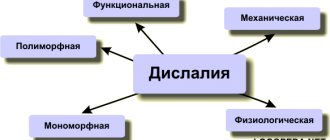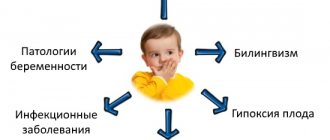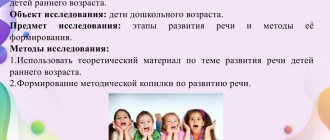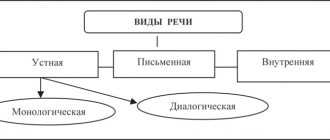Dysarthria is a disorder of the pronunciation aspect of speech caused by insufficient innervation of the speech apparatus, resulting in a violation of the neuromotor regulation of muscle tone as a result of damage to the central nervous system.
Dysarthria has several forms, each of which has its own neurological symptoms. The peculiarity of the speech of children with dysarthria is that their speech sounds “blurred”, unclear, and often inarticulate.
Specialists in the field of speech pathology in their interpretation of dysarthria and in approaches to its treatment rely on neurological ideas about the characteristics of the innervation of speech organs from the corresponding brain structures.
The etiology of dysarthria is local brain lesions (stroke, trauma, tumors) that cause organic damage to those brain structures that innervate the speech muscles.
In addition to speech problems, dysarthria also causes:
- Insufficient integration in the work of motor-kinesthetic, auditory-visual and auditory-kinesthetic systems;
- Muscle tone disorders (hypertonicity, hypotonicity or variable);
- Movement disorders (hyperkinesis, incoordination, synkinesis, oral automatisms such as sucking, moaning, smacking)
Severity of dysarthria
Dysarthria in a child has 3 degrees of severity:
- Anarthria is the complete absence of voice and speech. Some inarticulate sounds are possible.
- Direct dysarthria. The child is able to use oral speech, but it is inarticulate, incomprehensible to others, there are gross violations of sound pronunciation, and breathing, voice and intonation expressiveness are also significantly impaired.
- Erased dysarthria. This type of disease occurs most often. The child does not stand out much among his peers, but at the same time he is quite awkward, quickly gets tired in the process of performing loads, and has persistent disorders in the pronunciation of sounds (mostly hissing and whistling). When speaking, the child’s problems with articulation are not clearly expressed, the lips move minimally.
Signs of speech dysarthria
If the child cannot fully perform the movements necessary for speech.
How to check the mobility of a child’s speech organs?
- be able to open and close your mouth while “slapping” with your lips,
- be able to hold your mouth open for several seconds,
- open your mouth slightly, placing your wide tongue on your lower teeth and holding it there for several seconds,
- stick your tongue out of your mouth and put it back,
- be able to alternate between pulling your lips into a “tube” and a small smile (when performing this movement, your teeth should be closed and the movement is performed with your lips alone),
- do the “clock” exercise (alternately touch the corners of your mouth with your tongue),
- be able to raise the tongue on the upper lip and lower it on the lower lip several times,
- “lick” your upper lip,
- “puff out” your cheeks,
- make your cheeks “thin”,
- frown your eyebrows
- raise your eyebrows,
- blow on an imaginary candle.
What can parents be wary of?
- the child’s speech organs cannot maintain the same position for 5-6 seconds,
- if a child tries to keep his tongue motionless, the tongue turns blue from tension,
- if you notice increased salivation,
- inability to perform simple movements (pull your lips into a “tube” or “stick out and remove” your tongue,
- asymmetry in the work of the tongue muscles (when the tongue sticks out of the mouth, it deviates to the right or left),
- synchronous movements of the speech organs (performing one movement is accompanied by another; if a child raises his tongue, then his lower jaw rises behind his tongue; when the tongue moves left and right, the lower jaw makes similar movements),
- excessive range of motion (when touching the upper teeth, the tongue may stick out so that it touches the upper lip),
- difficult to switch from performing one movement to another,
- violation of muscle tone (muscles are either too relaxed, then the child’s face is mimic and the mouth is slightly open, or they are very tense, which makes it difficult to perform the necessary movements),
- twitching, trembling of individual muscle groups,
- strong nasalization of the voice, “nasal tone.”
With such disorders, the child cannot perform the movements necessary for full speech; he needs the help of a speech therapist who specializes in the correction of dysarthria and has the skills of speech therapy massage.
Forms of dysarthria in children
Depending on the location of the brain lesion, dysarthria in a child can have the following forms:
- Bulbar—the nuclei of the peripheral motor nerves located in the brain stem are affected;
- Pseudobulbar - caused by damage to the conduction systems that ensure the conduction of nerve impulses from the cerebral cortex to the nuclei of the medulla oblongata;
- Subcortical dysarthria is associated with damage to the subcortical nuclei, which are responsible for the regulation of muscle tone and emotional expressiveness of speech;
- Cortical—the cortical structures of the brain, which are responsible for the most subtle innervation of the speech muscles and the formation of speech praxis, are affected;
- Cerebellar - the nuclei and pathways of the cerebellum, which are responsible for coordination in the work of the respiratory, vocal, articulatory apparatus and for the emotional expressiveness of speech, are affected. Rarely found isolated from other species.
How to Diagnose and Treat the Disorder
Diagnosis of the disorder is the prerogative of neurology and speech therapy. Instrumental research methods play a special role in making a diagnosis: EEG, electroneurography, electromyography, MRI, transcranial magnetic stimulation.
The speech therapist, in turn, must examine the condition of the speech-motor organs, facial and facial muscles. The specialist evaluates the nature of speech: how understandable it is for perception, the correct pronunciation of individual sounds, its tempo, rhythm, intonation, volume, synchronicity of the articulatory apparatus, and grammatical aspects.
Written speech is assessed by asking the patient to copy some text or take dictation.
Treatment of the disorder should begin with relief of the underlying disease. But speech disorders cannot be ignored.
It is advisable to begin correction of dysarthria as quickly as possible. Feeling his own conversational peculiarities, the patient will try to limit communication in society. This will lead to worsening of the speech defect. For example, from the first stage it will develop into the second. Isolation can also make it difficult to understand normal speech.
Therefore, in addition to treating the underlying disease, correction of speech defects is carried out. For this purpose, physiotherapy methods are used:
- various types of massage, including Shiatsu - influencing reflexogenic points using the finger method;
- acupuncture;
- physical therapy, including the use of special simulators;
- medicinal baths.
It is permissible for a psychoneurologist to prescribe psychotropic drugs as aids to normalize the psycho-emotional background.
Speech therapy treatment consists of using:
- speech therapy massage – working out the facial muscles. It allows you to improve blood circulation and restore normal muscle tone. Used to improve speech motor skills;
- exercises for voice production - the work of the vocal cords, volume and timbre of the voice are regulated;
- finger gymnastics – development of fine motor skills of the hands, which is interconnected with speech function;
- learning to position the organs of articulation for correct pronunciation;
- prosodic exercises - work on intonation, strength, height, tempo of the voice. Helps eliminate monotony;
- breathing exercises. Her exercises establish the correct breathing rhythm during speech activity.
Among the psychotherapeutic techniques used:
- art therapy;
- laughter therapy;
- clay and wax therapy;
- aromatherapy;
- music therapy;
- chromotherapy or color therapy.
The integrated use of all treatment methods makes it possible to correct speech disorders. In some cases, dysarthria can be completely eradicated, in others, lasting positive changes can be achieved.
It is also important to teach patients how to live in society with their problem. People with dysarthria are taught to establish eye contact with the interlocutor, use nonverbal methods of expression - gestures, pictures, etc., and the ability to recognize that the interlocutor has understood him.
Causes of dysarthria in children
The causes of dysarthria are organic lesions of the central and peripheral nervous system.
These include: asphyxia, birth injuries, hemolytic disease, infectious diseases, traumatic brain injuries, cerebrovascular accidents, brain tumors.
How to treat dysarthria in a child?
Examination and subsequent treatment of dysarthria in a child is carried out by a neuropsychologist, speech therapist and neurologist. It is extremely important to conduct neuropsychological diagnostics, differential speech therapy diagnostics, as well as EEG, USDG, and, if indicated, MRI of the brain.
Correction in the treatment of dysarthria is based on its form, the child’s age and level of development (speech, motor and higher mental functions).
The basic principles of treating dysarthria in a child are:
- Complexity of corrective effects. The following should take part in the correction: neurologist, neuropsychologist, speech therapist;
- Early start of work;
- Following the laws of normal ontogenesis;
- Reliance on preserved or restored functions;
- Active involvement of parents in the correction process.
Treatment for dysarthria includes:
- neuropsychological correction (sensorimotor and cognitive);
- sensory integration;
- cerebellar stimulation;
- speech therapy massage (according to indications);
- work with sound pronunciation and syllabic structure of words;
- correction of the tempo-rhythmic structure of speech;
- regulation of speech breathing;
- development of the lexical and grammatical structure of speech;
- correction or prevention of writing and reading disorders;
- drug therapy (according to indications);
- physical therapy (for cerebral palsy).
Examples of corrective exercises
Motor skills disorders in children with dysarthria require individual lessons in special institutions and at home. The child’s education is carried out in different areas: the development of motor skills (general, fine, articulation), correction of sound pronunciation, formation of the rhythmic and melodic side of speech and improvement of diction. In order for a child to develop strong skills in the entire motor sphere, it takes a long time and the use of a variety of forms and teaching methods.
For example, work on motor functions is carried out using exercises both statically (stable positions, such as holding arms, legs, certain articulatory positions while counting) and dynamically (movement). Attention is paid to the spatial organization of movements (tilts, turns, steps in different directions), voluntary regulation of movements (for example, stopping at a signal), tempo-rhythm (movements to count, clapping actions, throwing balls or bags to count on a balancing board).
Correction of sound pronunciation
The peculiarity of voice correction for dysarthria is that it is a complex and lengthy process. From a physiological point of view, teaching a person to pronounce sounds is tantamount to creating a new conditioned reflex. If for dyslalia the method of staging by imitation is very effective, then for dysarthria speech therapists more often use a mixed method using mechanical assistance, speech therapy probes and the method of passive formation of articulatory structure, when the speech therapist, with the help of hands, special devices and probes, gives the patient’s tongue and lips the desired position . You can use auxiliary objects: a teaspoon, tubes, sticks of various diameters.
Voice correction technology for dysarthria is a long-term, painstaking and systematic work on the development of articulatory motor skills and automation of delivered sounds. Articulatory gymnastics and speech therapy massage do not stop at the stage of voice development, but are continued and combined. Speech therapists use individual techniques for producing sounds, analyzing the causes and nature of disorders.
Specific speech development disorders (Recommendations for speech therapists)
03.02.2014 Specific speech development disorders
- disorders in which the normal acquisition of language skills is impaired already in the early stages of development. These conditions are not directly related to neurological or language impairments, sensory deficits, mental retardation, or environmental factors. Children with a specific speech disorder experience the need for communication, are able to adequately communicate with others and have the proper level of development.
Specific speech disorder is a disorder in which a child's speech skills are below normal for age, despite the absence of brain damage, adequate mental development, normal hearing, properly developed articulatory apparatus and normal conditions for language acquisition. Children with specific speech disorder usually begin to speak late; their first words may not appear until the age of two years. They also learn words poorly, which is reflected in lexical poverty of speech. In addition, there is evidence of insufficient development of short-term memory associated with speech. This is expressed in the inability to perceive long complex sentences, especially at a fast pace of speech. Therefore, those suffering from a specific speech disorder almost always speak in short sentences. The greatest difficulties in children with specific speech disorder are observed in syntax: errors or omissions in the construction of phrases or sentences that violate the rules of word connection.
Previously, it was believed that specific speech disorder was a delay in language development in preschool children. However, further speech difficulties have been shown to occur in adolescents and adults. Thus, 70% of children diagnosed with a specific speech disorder at the age of five still experienced some speech difficulties at the age of 20.
Delayed speech development is often accompanied by difficulties in reading and writing, disturbances in interpersonal relationships, and emotional and behavioral disorders. There are several types of such disorders.
1. Specific articulation disorder
speech is characterized by repeated and frequent disturbances of speech sounds. The child’s use of sounds below the level corresponding to his mental age, that is, his acquisition of speech sounds is either deviated or delayed, leading to disarticulation with difficulties in understanding his speech, substitutions, omissions, distortions of speech sounds, changes depending on their combination (this is correct says no). The basis of the articulation defect is the inability to voluntarily accept and maintain certain positions of the tongue, palate, lips necessary for pronouncing sounds.
2. Expressive language disorder
(speech therapy classification - general speech underdevelopment) is one of the forms of a specific speech development disorder, in which the child’s ability to use spoken language is below the level, although speech understanding usually does not suffer.
With general underdevelopment of speech, there is a poverty of vocabulary, a low level of verbal generalization, difficulties in developing speech utterances, agrammatisms (errors in the use of verbal endings, violations of word formation), difficulties in the use of prepositions, verbs, and conjunctions. Characterized by adequate use of non-verbal cues, gestures, and the desire to communicate. Although normal speech development is highly individualized, the absence of single words or word-like speech formations by two years, or simple phrases of 2-3 words by three years, should be considered a sign of delay.
3. Receptive language disorder
is a specific disorder of the child’s speech function, in which, against the background of preserved function of the hearing aid and normal mental development, the child poorly understands speech addressed to him. There is often a defect in phonetic-phonemic analysis and verbal-sound pronunciation. Children with receptive language disorder do not acquire the ability to correctly identify various objects, cannot follow simple verbal instructions, are not able to understand questions, comparisons and negations, and do not differentiate intonation and tone of voice. Such children have no relationship between a separate object or action and the word denoting it. With this speech disorder, the child’s intellectual and mental development is delayed.
4. Specific reading disorder
is a reading delay and impairment that cannot be explained by mental retardation or inadequate instruction and that is not the result of a visual impairment, hearing impairment, neurological disorder, or inadequate attitude to the school curriculum. When learning the alphabet, such children aged 7-8 years have difficulty retelling and distributing sounds into categories. In a later period, reading disorders such as distortions of parts of words, substitutions, incorrect additions, omissions, rearrangement of words and sentences or letters in words occur. Also, a reading disorder is indicated by a slow pace, misunderstanding of what was read, inaccuracy of what was read, and attempts to start reading the text from the beginning.
5. Specific spelling disorder
- writing disorder. In this disorder, the ability to spell words or write words correctly is impaired. When writing, there are no phonetic errors; the alternation of letters, the writing of prefixes, suffixes, and endings are more impaired; difficulties are manifested in spelling and expressing thoughts in an age-appropriate grammatical form.
Underdevelopment of speech inhibits the development of a child’s cognitive activity, which often manifests itself as a delay in mental development in general.
Literature used: Polushkina N.N., “Diagnostic reference book for speech therapist”, M ed. "Arstel
The material was prepared by: N.V. Mikhailova, speech therapist at RMPK.









